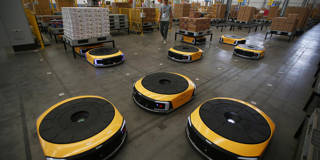The COVID-19 pandemic has prompted an increasing number of rich-country firms to reduce their reliance on global supply chains and invest more in robots at home. But it is probably too soon to tell whether this switch will increase productivity growth in advanced economies.
MUNICH – Since the mid-2000s, productivity growth in advanced economies has been anemic. Average annual productivity growth in the United States from 2005 to 2016 was just 1.3%, less than half of the 2.8% annual growth rate recorded between 1995 and 2004. Across other OECD countries, annual productivity growth declined from 2.3% in the 1995-2004 period to 1.1% between 2005 and 2015.
This sluggish growth appears paradoxical, given recent rapid advances in digital innovation and artificial intelligence. As Erik Brynjolfsson, Daniel Rock, and Chad Syverson have noted, “we see transformative new technologies everywhere but in the productivity statistics.” But might the COVID-19 pandemic help to resolve the paradox by accelerating firms’ adoption of robots and other labor-saving innovations, thereby boosting productivity growth?
Recent research that I co-authored shows that the pandemic has prompted an increasing number of rich-country firms to reduce their reliance on global supply chains and invest more in robots at home. This is because the pandemic has changed the relative costs of these two production models. Global supply chains have become costlier and more uncertain, with many firms anticipating further lockdown-related disruptions to production. At the same time, the decrease in interest rates during the ongoing economic crisis has enabled cheaper financing, thereby lowering the cost of a robot relative to that of a worker.

MUNICH – Since the mid-2000s, productivity growth in advanced economies has been anemic. Average annual productivity growth in the United States from 2005 to 2016 was just 1.3%, less than half of the 2.8% annual growth rate recorded between 1995 and 2004. Across other OECD countries, annual productivity growth declined from 2.3% in the 1995-2004 period to 1.1% between 2005 and 2015.
This sluggish growth appears paradoxical, given recent rapid advances in digital innovation and artificial intelligence. As Erik Brynjolfsson, Daniel Rock, and Chad Syverson have noted, “we see transformative new technologies everywhere but in the productivity statistics.” But might the COVID-19 pandemic help to resolve the paradox by accelerating firms’ adoption of robots and other labor-saving innovations, thereby boosting productivity growth?
Recent research that I co-authored shows that the pandemic has prompted an increasing number of rich-country firms to reduce their reliance on global supply chains and invest more in robots at home. This is because the pandemic has changed the relative costs of these two production models. Global supply chains have become costlier and more uncertain, with many firms anticipating further lockdown-related disruptions to production. At the same time, the decrease in interest rates during the ongoing economic crisis has enabled cheaper financing, thereby lowering the cost of a robot relative to that of a worker.